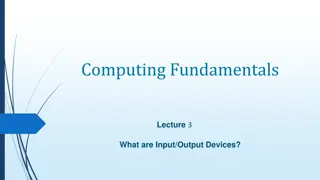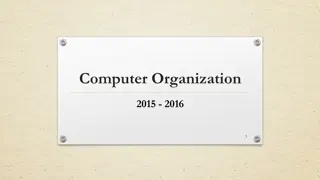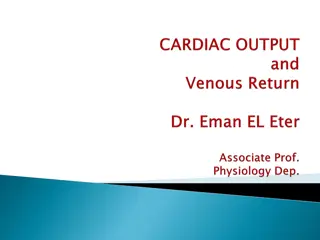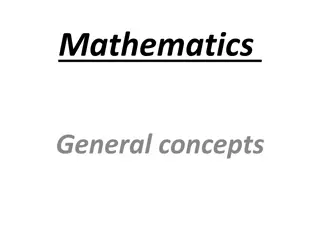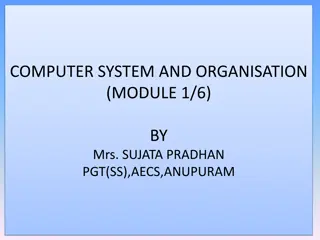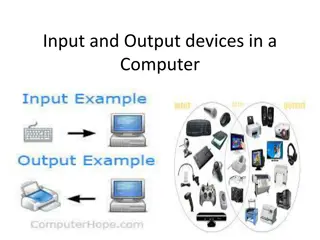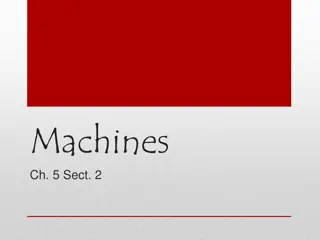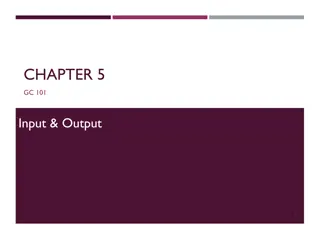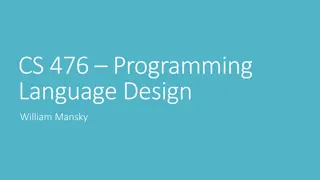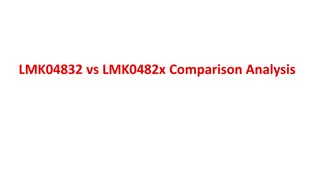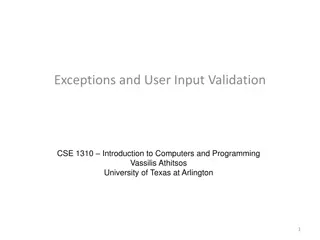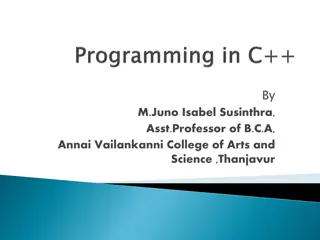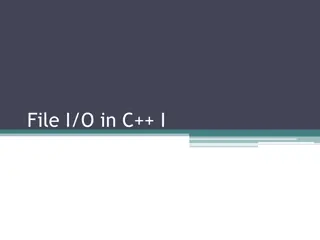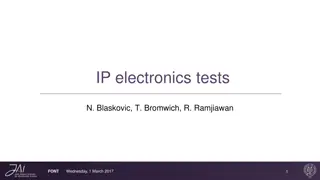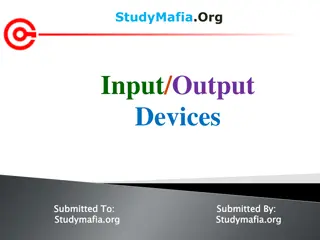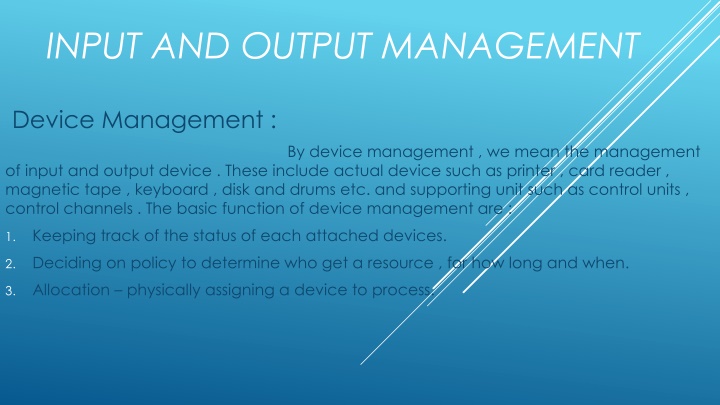
Input and Output Management in Device Management
Learn about the management of input and output devices, dedicated and shared devices, input/output devices, and input devices in computer systems. Explore the functions, allocation methods, and complexities involved in managing various types of devices efficiently.
Download Presentation

Please find below an Image/Link to download the presentation.
The content on the website is provided AS IS for your information and personal use only. It may not be sold, licensed, or shared on other websites without obtaining consent from the author. If you encounter any issues during the download, it is possible that the publisher has removed the file from their server.
You are allowed to download the files provided on this website for personal or commercial use, subject to the condition that they are used lawfully. All files are the property of their respective owners.
The content on the website is provided AS IS for your information and personal use only. It may not be sold, licensed, or shared on other websites without obtaining consent from the author.
E N D
Presentation Transcript
INPUT AND OUTPUT MANAGEMENT Device Management : By device management , we mean the management of input and output device . These include actual device such as printer , card reader , magnetic tape , keyboard , disk and drums etc. and supporting unit such as control units , control channels . The basic function of device management are : Keeping track of the status of each attached devices. Deciding on policy to determine who get a resource , for how long and when. Allocation physically assigning a device to process. 1. 2. 3.
DEDICATED DEVICES A dedicated device is allocated to a job for the jobs entire duration . Some device lend themselves to this form of allocation . It is difficult , for example , to share a card reader tape , or printer . If several user want to use the printer at the same time , would they cut up there appropriate output and paste it together .
SHARED DEVICES There are some device such as disks , drums that may be shared con currently by more than one job . Information stored on a direct access device is directly accessible . Several processes can be read form a single device essentially at the same times . The management of a shared device can be become quite complicated , particularly if utmost efficiency is desired . There are two problem associated with the use of shared device must be handled by the operating system . Since there is a little interference caused by multiple jobs sharing access to the device let to process simultaneously request a read form disk . A , so some mechanism must be employed to determine which request should be handled first . This may be done by the software or by the hardware . Policy for establishing which processes request is to be satisfied first , might be based on . (a) A priority list. (b) The objective of achieving improved system output.
INPUT/OUTPUT DEVICES As you know , the computer works on input process - process output cycle . The user firstly feeds the data to computer in form of understandable by him . The data are converted into machine language that is understandable by the input unit of the computer . The input data are stored in memory from where they are taken out for processing and after processing , the is generated . The generated result is sent to output unit where it is converted into the user understandable form . These section deals with the variety of input output device and storage device .
INPUT DEVICES Input device are the device used to supply input to the computer . It is the first phase of the data processing process . There is a variety of device in the category . We will have a brief look at commonly used input device one by one. (a) Keyboard : This is most common and popular device . It is used key in the character by typing them . A standard 104 keys is most common and it is contain following keys: Numeric keys Character keys Special keys Function keys 1. 2. 3. 4. (b) Mouse : it is another popular point input device generally used in graphic use of interface system in which we interact with computer through picture . A mouse is pointing device which is used to supply input through a graphical a representation called cursor .
INPUT DEVICES (c) Microphone : microphones are plugged into sound input socket on the sound card of the computer . As more and more people have started using computer for listening , recording music , internet telephony , chatting microphone is one of the most commonly device to input voice . It translates the analog voice signal into computer understandable digital form . (d) Light pen : you must have seen the commentators marking a portion of screen while explaining a particular area of the field set a particular shot of a batsman in a cricket match . This is done with light pen . It is type of pointing devices that is used to choose a displayed menu on screen for a program . Light pen does not emit light; rather it react to light through a photo sensitive detector at its base . (e) Scanners : scanners are the other very popular other input device they are used to transfer printed or handmade picture or drawing into computer . A broad variety of scanners has specific area of application . (f) Joystick : the device is particularly used to for user who uses computer for playing games . It is generally a vertical stick having various buttons mounted on it for various kinds of inputs . The function of these button may change depending upon the game you are playing .
OUTPUT DEVICES Output is the third phase of processing cycle . In the information is displayed in form hard or soft after the processing of data . Output device are the devices used for displaying this output . The output devices may be divided in two board categories. . Soft copy output . Hard copy output Soft copy : this is the type of output which is available to the user till the computer is powered on . This cannot be referred at any point of time for ex. The output we seen on screen of our monitor is available till the computer is on. Hard copy : it is a type of output which can be read directly and immediately this form of output referred at any point of time without any regard to computer . This type of output is generally produced on a paper printed form this permanent type of output. 1. 2.
OUTPUT DEVICES . Soft copy devices : we have separate devices for both types of outputs . (a) Computer , monitor (b) Flat panel display . Hard copy devices : these are the device which produce hardcopy of the output , generally on paper . These are very slow in operation as compared to the monitor . The main class of devices , which is discussed in this section , is printers .
PRINTERS Printer are the output device , which produce hard copy of output generally on paper . It the most common medium to distribute text and graphics to other . The quality of output is analysed in terms of dot per inch i.e. how many dots a printer prints on a unit area of a paper . More are dots , better is output quality . Today , printers offers many options about the choice of resolution , which can be chosen by user . Impact printer Non-impact printer 1. 2.
IMPACT PRINTERS These are printers that prints by having a physical contact between the printer head and paper to print the desired image . There are two sub categories of printers in the class i.e. serial printer or character printer and line printer . Dot matrix printer . Daisy wheel printer . Line printer . 1. 2. 3. Chain printer . Drum printer . 4. 5.
NON-IMPACT PRINTERS This is the category of printer which is print without any physical contact with the paper . The printers belonging to the category generally print by using electric , heat and pressure or laser technology . Non-impact printer have greater resolution then the impact printer . The most important property which is not there in impact printer as that most not of the non- impact printers can print coloured outputs . Inkjet printer 1. Laser printer Plotters Thermal wax printers 2. 3. 4.



